For 124 years, from 1838 to 1962, it stood proudly at the entrance to Euston Station, even surviving German zeppelin raids and attacks from the Luftwaffe.
Then, in 1962, it was controversially demolished to make way for a modern train station.
It was 70 feet high and was the world's biggest Doric gateway. Written on it was only the word "EUSTON." Dubbed "the first great building of the railway age" it was magnificent Victorian British accomplishment.
Students even scaled the arch in protest at its demolition.
But it was still demolished, and its stones were dumped into the River Lea.
But British Waterways dredged the itand managed to salvage the discarded rock on behalf of the Euston Arch Trust as it carries out repair work to the waterways, which are around the site of the 2012 London Olympics.
Now an ambitious £10million design to rebuild the 70ft arch on the original site with a nightclub in the foundations and lifts rising up the pillars to the banqueting hall, seating around 80 diners, has been unveiled.
Beneath the banqueting hall the building will be open and buses and taxis will be able to drive through it.
The reconstruction will start next year.
Historic railway arch destroyed by 60s planners to be rebuilt after remains were found dumped in river
By Daily Mail Reporter
23rd September 2009
Daily Mail
An historic arch which once stood proudly at the entrance to Euston Station before being demolished by town planners almost 50 years ago is to be restored to its former glory after the discovery of lost stones dumped in a river.
The plans were unveiled by the Euston Arch Trust which has campaigned for the rebuilding of the Greek revival landmark.
Co-founder Dan Cruickshank said: 'The forthcoming redevelopment of Euston Station provides an unmissable opportunity to reinstate the spectacular Euston Arch.
'We’re talking about a building of international importance. Once reconstructed, it would vastly improve the public realm, attracting investment and visitors to this part of London.'
The Euston Arch was built in 1838 and, towering 70ft above the ground, it was the biggest Doric gateway in the world.
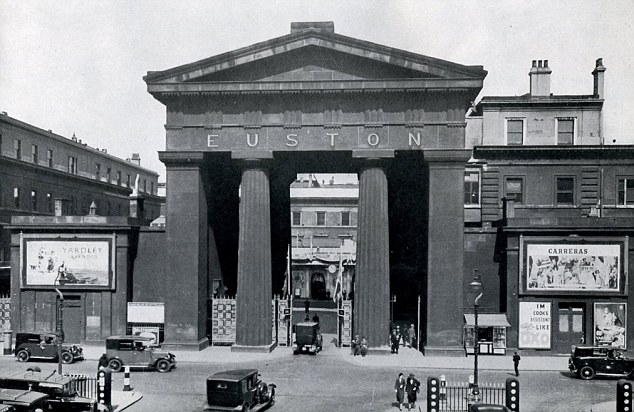
Imposing: How the Euston Arch looked during its centenary in 1938, 44 years before it was torn down
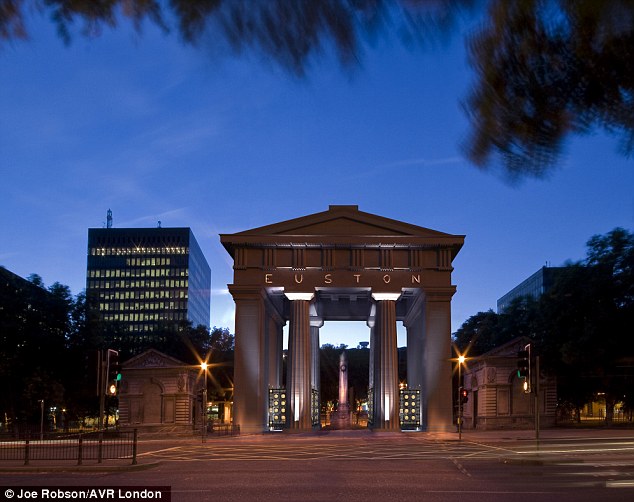
Plan: How the 70ft arch will look once the reconstruction project begins. It is due to start next year
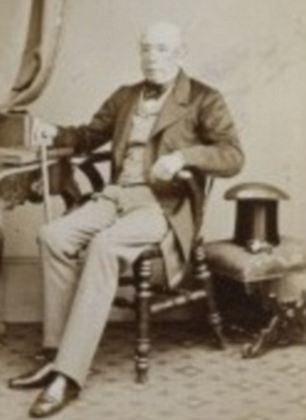
Philip Hardwick who designed the Euston Arch in the 1830s and worked on the construction of the station itself
The arch dominated the station from 1838 until 1962 when both were controversially demolished to make way for a modern station. The protests at its destruction attracted prominent figures such as Sir John Betjeman.
A group of students even climbed scaffolding around the arch as demolition of the 4,500 ton structure was due to take place and unfurled a banner pleading for it to be saved.
But it was all to no avail and its stones were dumped into a tributary of the River Lea in East London to fill a hole in the riverbed.
But British Waterways dredged the channel and managed to salvage the discarded rock on behalf of the Euston Arch Trust as it carries out repair work to the waterways around the 2012 Olympic site.
Now the trust has unveiled an ambitious £10million design to rebuild the 70ft arch on the original site with a nightclub in the foundations and lifts rising up the pillars to the banqueting hall, seating around 80 diners.
Beneath the banqueting hall the building will be open and buses and taxis will be able to drive through it.
The plans could form part of the major redevelopment of Euston station after it was announced the old terminal would be demolished and rebuilt at a cost of £1billion.
The campaign to rebuild the Euston Arch has been immensely popular in London attracting support from architects, historians and celebrities.
The whereabouts of the arch's stones, however, were unknown until architectural historian and TV presenter Dan Cruickshank tracked them down in the Prescott Channel in 1994.
Since then he and others, including former Monty Python Michael Palin, have been campaigning for the restoration of what has been described as ‘the first great building of the railway age’.

Former Monty Python star Michael Palin
Mr Palin, speaking about the project, wrote: 'The enormous popularity of the restored St Pancras has shown that celebration of the past and potential of the future are not mutually exclusive.
'The restoration of Euston Arch would restore to London's oldest mainline terminus some of the character and dignity of its great neighbours.'
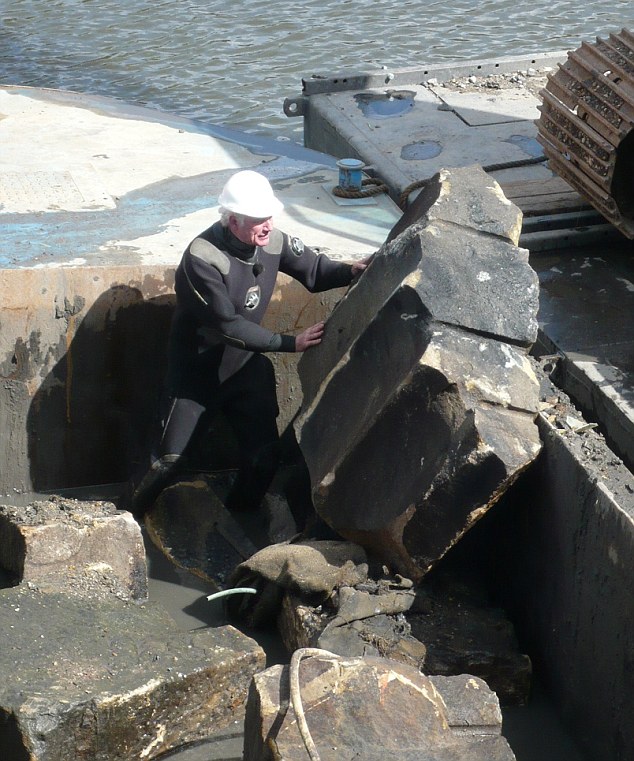
Returned: Vast chunks of the structure are salvaged. It had been used to fill a chasm in the River Lea

Easy does it: A worker helps direct a mechanical digger lift some of the dumped masonry in East London
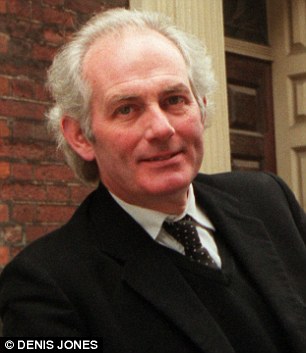
Historian Dan Cuickshank tracked down the stone
Now the 70ft 6in Doric propylaeum [the structure forming the entrance to a temple]will be rebuilt at the place it stood for 124 years as an imposing symbol of Victorian industrial optimism.
Its architect, Philip Hardwick, built it at a cost of £35,000 (£2.5million in today’s money) after being inspired by classical buildings in Rome during a trip to Italy in 1818.
It was only 32 years after it was built that the golden letters 'Euston' were carved into the stone.
The station which opened on July 20, 1837, a year before the arch was finished, was the terminus of the London and Birmingham Railway constructed by Robert Stephenson. At first the station had only two platforms, one for departures and one for arrivals.
The Euston Arch, built from Yorkshire stone, complemented the Ionic entrance to the Curzon Street Station in Birmingham which was the other end of the railway's mainline.
Using stone quarried at Bramley, West Yorkshire, Mr Hardwick, who also helped design Liverpool’s Royal Albert Dock, created the arch as the magnificent centrepiece of Euston station.
However, as the 1960s approached, the station’s owners, the British Transport Commision, increasingly saw it more as a mere obstacle to change.
They wanted to build a bigger terminal as part of plans to upgrade and electrify the West Coast Main Line.
So, with much anger, the Grade II arch – along with Euston’s Great Hall – was granted permission to be demolished in 1962.
The Euston Arch Trust, which has led the campaign to restore it, said the decision confirmed that ‘blandness and lack of imagination had replaced the heroic vision of the past’.
Mr Cruickshank added: ‘Its destruction was an act of barbarism. Now a great cultural wrong can be put right.’
For the past four months, British Waterways has been dredging the channel to salvage the discarded rock of what was the largest Doric arch ever built, on behalf of the Euston Arch Trust.
Now the trust has unveiled its radical plan to rebuild the arch on the original site. The rebuild will look identical to the original on the outside, but will have hospitality space inside to be leased out to help pay for the project.
An underground nightclub in the foundations will have the capacity for several hundred people, with lifts rising up the pillars of the arch to a banqueting hall, seating 80 diners.
Proposals are expected to be submitted to planning officers next year.

Glory days: The arch, which only had the letters Euston inscribed 32 years after it was constructed, was the centrepiece of Euston station and represented an era of Victorian optimism
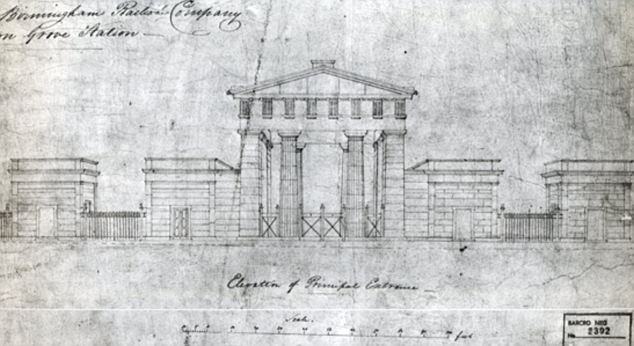
The plans for the arch which was designed by Phlilp Hardwick
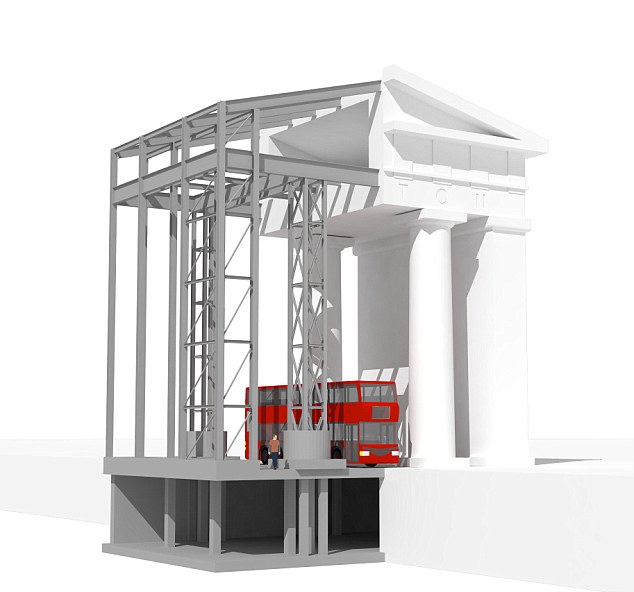
Design: Plans showing how the arch will be rebuilt using a steel structure. Underneath will be a nightcub
dailymail.co.uk
Then, in 1962, it was controversially demolished to make way for a modern train station.
It was 70 feet high and was the world's biggest Doric gateway. Written on it was only the word "EUSTON." Dubbed "the first great building of the railway age" it was magnificent Victorian British accomplishment.
Students even scaled the arch in protest at its demolition.
But it was still demolished, and its stones were dumped into the River Lea.
But British Waterways dredged the itand managed to salvage the discarded rock on behalf of the Euston Arch Trust as it carries out repair work to the waterways, which are around the site of the 2012 London Olympics.
Now an ambitious £10million design to rebuild the 70ft arch on the original site with a nightclub in the foundations and lifts rising up the pillars to the banqueting hall, seating around 80 diners, has been unveiled.
Beneath the banqueting hall the building will be open and buses and taxis will be able to drive through it.
The reconstruction will start next year.
Historic railway arch destroyed by 60s planners to be rebuilt after remains were found dumped in river
By Daily Mail Reporter
23rd September 2009
Daily Mail
An historic arch which once stood proudly at the entrance to Euston Station before being demolished by town planners almost 50 years ago is to be restored to its former glory after the discovery of lost stones dumped in a river.
The plans were unveiled by the Euston Arch Trust which has campaigned for the rebuilding of the Greek revival landmark.
Co-founder Dan Cruickshank said: 'The forthcoming redevelopment of Euston Station provides an unmissable opportunity to reinstate the spectacular Euston Arch.
'We’re talking about a building of international importance. Once reconstructed, it would vastly improve the public realm, attracting investment and visitors to this part of London.'
The Euston Arch was built in 1838 and, towering 70ft above the ground, it was the biggest Doric gateway in the world.

Imposing: How the Euston Arch looked during its centenary in 1938, 44 years before it was torn down

Plan: How the 70ft arch will look once the reconstruction project begins. It is due to start next year

Philip Hardwick who designed the Euston Arch in the 1830s and worked on the construction of the station itself
The arch dominated the station from 1838 until 1962 when both were controversially demolished to make way for a modern station. The protests at its destruction attracted prominent figures such as Sir John Betjeman.
A group of students even climbed scaffolding around the arch as demolition of the 4,500 ton structure was due to take place and unfurled a banner pleading for it to be saved.
But it was all to no avail and its stones were dumped into a tributary of the River Lea in East London to fill a hole in the riverbed.
But British Waterways dredged the channel and managed to salvage the discarded rock on behalf of the Euston Arch Trust as it carries out repair work to the waterways around the 2012 Olympic site.
Now the trust has unveiled an ambitious £10million design to rebuild the 70ft arch on the original site with a nightclub in the foundations and lifts rising up the pillars to the banqueting hall, seating around 80 diners.
Beneath the banqueting hall the building will be open and buses and taxis will be able to drive through it.
The plans could form part of the major redevelopment of Euston station after it was announced the old terminal would be demolished and rebuilt at a cost of £1billion.
The campaign to rebuild the Euston Arch has been immensely popular in London attracting support from architects, historians and celebrities.
The whereabouts of the arch's stones, however, were unknown until architectural historian and TV presenter Dan Cruickshank tracked them down in the Prescott Channel in 1994.
Since then he and others, including former Monty Python Michael Palin, have been campaigning for the restoration of what has been described as ‘the first great building of the railway age’.
Former Monty Python star Michael Palin
Mr Palin, speaking about the project, wrote: 'The enormous popularity of the restored St Pancras has shown that celebration of the past and potential of the future are not mutually exclusive.
'The restoration of Euston Arch would restore to London's oldest mainline terminus some of the character and dignity of its great neighbours.'

Returned: Vast chunks of the structure are salvaged. It had been used to fill a chasm in the River Lea

Easy does it: A worker helps direct a mechanical digger lift some of the dumped masonry in East London

Historian Dan Cuickshank tracked down the stone
Now the 70ft 6in Doric propylaeum [the structure forming the entrance to a temple]will be rebuilt at the place it stood for 124 years as an imposing symbol of Victorian industrial optimism.
Its architect, Philip Hardwick, built it at a cost of £35,000 (£2.5million in today’s money) after being inspired by classical buildings in Rome during a trip to Italy in 1818.
It was only 32 years after it was built that the golden letters 'Euston' were carved into the stone.
The station which opened on July 20, 1837, a year before the arch was finished, was the terminus of the London and Birmingham Railway constructed by Robert Stephenson. At first the station had only two platforms, one for departures and one for arrivals.
The Euston Arch, built from Yorkshire stone, complemented the Ionic entrance to the Curzon Street Station in Birmingham which was the other end of the railway's mainline.
Using stone quarried at Bramley, West Yorkshire, Mr Hardwick, who also helped design Liverpool’s Royal Albert Dock, created the arch as the magnificent centrepiece of Euston station.
However, as the 1960s approached, the station’s owners, the British Transport Commision, increasingly saw it more as a mere obstacle to change.
They wanted to build a bigger terminal as part of plans to upgrade and electrify the West Coast Main Line.
So, with much anger, the Grade II arch – along with Euston’s Great Hall – was granted permission to be demolished in 1962.
The Euston Arch Trust, which has led the campaign to restore it, said the decision confirmed that ‘blandness and lack of imagination had replaced the heroic vision of the past’.
Mr Cruickshank added: ‘Its destruction was an act of barbarism. Now a great cultural wrong can be put right.’
For the past four months, British Waterways has been dredging the channel to salvage the discarded rock of what was the largest Doric arch ever built, on behalf of the Euston Arch Trust.
Now the trust has unveiled its radical plan to rebuild the arch on the original site. The rebuild will look identical to the original on the outside, but will have hospitality space inside to be leased out to help pay for the project.
An underground nightclub in the foundations will have the capacity for several hundred people, with lifts rising up the pillars of the arch to a banqueting hall, seating 80 diners.
Proposals are expected to be submitted to planning officers next year.

Glory days: The arch, which only had the letters Euston inscribed 32 years after it was constructed, was the centrepiece of Euston station and represented an era of Victorian optimism

The plans for the arch which was designed by Phlilp Hardwick

Design: Plans showing how the arch will be rebuilt using a steel structure. Underneath will be a nightcub
dailymail.co.uk
Last edited: